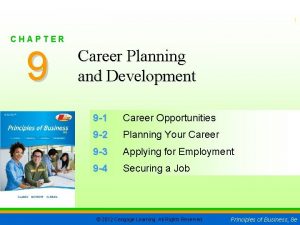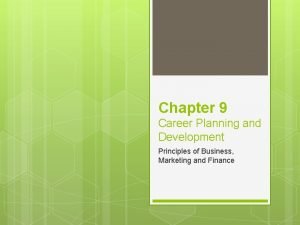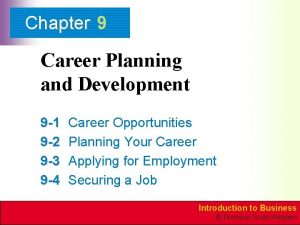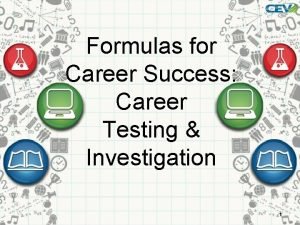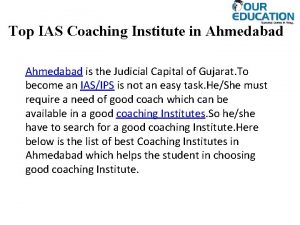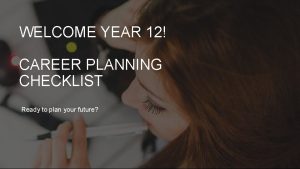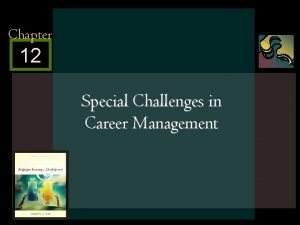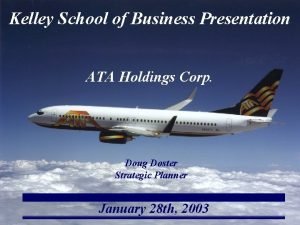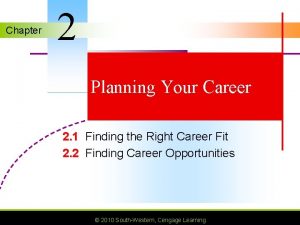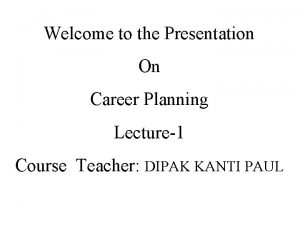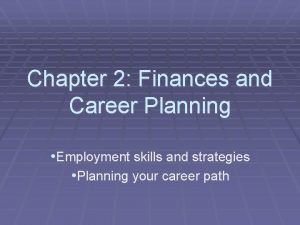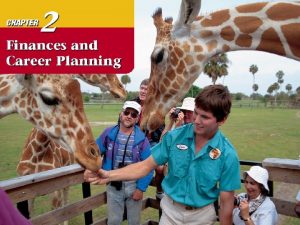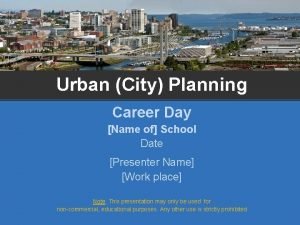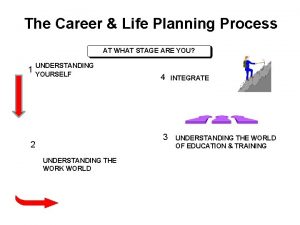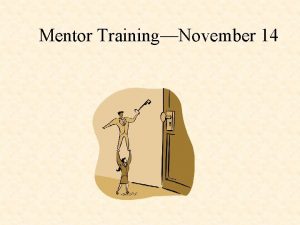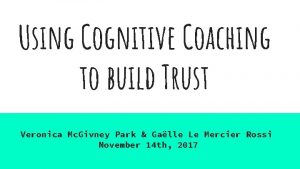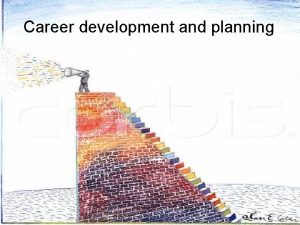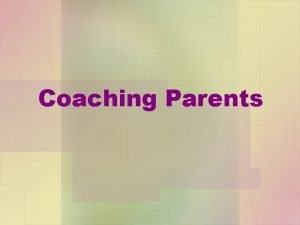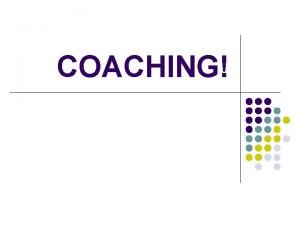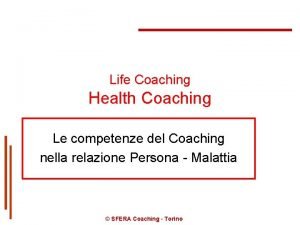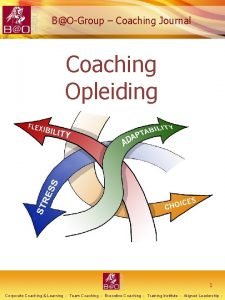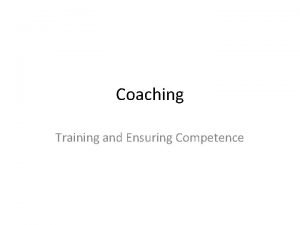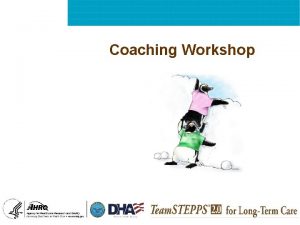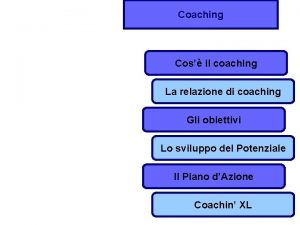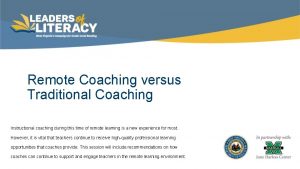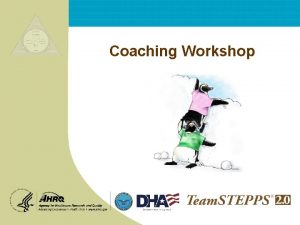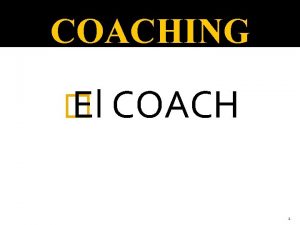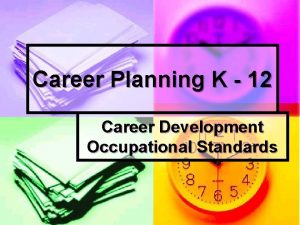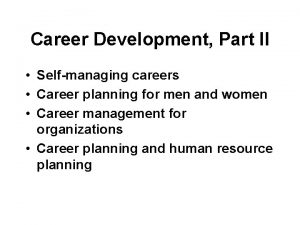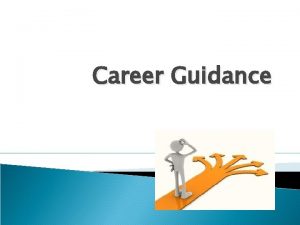Coaching for Development Development Planning Career Coaching Date
![Coaching for Development: Development Planning & Career Coaching [Date] © 2014 Coaching for Development: Development Planning & Career Coaching [Date] © 2014](https://slidetodoc.com/presentation_image_h2/2595b36d11d92481cdbfc761772c3d5f/image-1.jpg)







![Why Invest in Managers as Coaches? [org name] is more clearly defining roles and Why Invest in Managers as Coaches? [org name] is more clearly defining roles and](https://slidetodoc.com/presentation_image_h2/2595b36d11d92481cdbfc761772c3d5f/image-9.jpg)










![Name Future Responsibilities or Roles [org name] Lens • What are [org name] ’s Name Future Responsibilities or Roles [org name] Lens • What are [org name] ’s](https://slidetodoc.com/presentation_image_h2/2595b36d11d92481cdbfc761772c3d5f/image-20.jpg)









![Peter Johnson Description Job & Tenure Strengths • Program Director • With [org name] Peter Johnson Description Job & Tenure Strengths • Program Director • With [org name]](https://slidetodoc.com/presentation_image_h2/2595b36d11d92481cdbfc761772c3d5f/image-30.jpg)






- Slides: 36
![Coaching for Development Development Planning Career Coaching Date 2014 Coaching for Development: Development Planning & Career Coaching [Date] © 2014](https://slidetodoc.com/presentation_image_h2/2595b36d11d92481cdbfc761772c3d5f/image-1.jpg)
Coaching for Development: Development Planning & Career Coaching [Date] © 2014

Feed Forward Roles 1. Receiver Accept Feed Forward--listen to the suggestions for the future and learn as much as you can. 2. Coach Provide Feed Forward--give someone else suggestions for the future and help as much as you can. © 2 2014 2

Feed Forward Instructions • Receiver § Pick ONE significant behavior you would like to change in your life. § Describe this behavior to a partner, e. g. “I want to be a better listener. ” § Ask for 2 suggestions for the future that will help you make a positive change. (If you have worked together in the past, do not give ANY feedback about the past, only ideas about the future. ) § Listen attentively and take notes. Receivers are not allowed to comment on suggestions in any way, neither a critique or a judgment, e. g. “That’s a good idea. ” Just listen and then thank the Coach for their suggestions. • Coach § Ask the Receiver what they would like to change; provide 2 suggestions aimed at helping the other person change. § Say “You are welcome” when thanked for suggestions. © 3 2014 3

Feed Forward Debrief It’s about… • Letting go of the past • Listening to suggestions without judging • Learning as much as you can • Helping as much as you can • Learning points to help you be a great coach Source: “Helping Successful People Get Even Better” by Marshall Goldsmith © 4 2014 4

Today’s Purpose & Learning Outcomes Purpose • Understand the importance of development planning and career coaching (and how it is distinct from performance management) • Engage you in the coaching model for developing your direct reports • Provide an opportunity to learn and practice coaching skills and encourage implementation of these skills to increase the development of [org name] employees • Train leaders to deliver more effective feedback, development planning and career coaching Learning Outcomes • Understand the distinction between performance management and development planning and career coaching • Understand the approach and steps of good development-oriented coaching discussions • Better integrate the skills of development planning and career coaching into manager’s toolkit • Leaders can deliver more effective feedback, development planning and career coaching © 5 2014 5

Ground Rules We are all accountable for achieving today’s goal Everyone participates Different ideas are welcome – take risks, standup, support Keep discussion focused on topic: use agenda & parking lot Limit side conversations Start on time; end on time Follow through on action plans © 6 2014 6

Agenda Time Topic 15 min Feed Forward Exercise 5 min Session Objectives and Plan 5 min Connecting to our [org name] Tools and Calendar 10 min Introduction to Coaching 15 min Using Coaching Framework for Development Planning and Career Coaching Discussions 35 min Mini-Case: Development Planning and Career Coaching Discussion and Debrief for Lessons Learned 5 min Close © 7 2014 7

Introduction to Coaching © 2014
![Why Invest in Managers as Coaches org name is more clearly defining roles and Why Invest in Managers as Coaches? [org name] is more clearly defining roles and](https://slidetodoc.com/presentation_image_h2/2595b36d11d92481cdbfc761772c3d5f/image-9.jpg)
Why Invest in Managers as Coaches? [org name] is more clearly defining roles and accountability for leaders and supervisors to coach and develop their staff [org name] is committed to learning and growth • Stronger skills, habits & systems are needed for: • Setting SMART goals that are cascaded from strategic plans and organizational and affiliate goals • Supporting staff with frequent feedback and problem solving to achieve current performance goals • Coaching employees on development that prepares for future individual and organizational needs • Coaching is an investment in our people that builds our capabilities as a collective and supports individual growth • Coaching improves organizational performance and innovation • Coaching builds stronger relationships © 9 2014 9

Boss versus Coach Traditional Boss • Talks • Tells • Presumes • Seeks control • Assigns blame • Can be distant Manager as Coach • Listens • Asks • Explores • Seeks commitment • Takes responsibility • Connects © 10 2014 10

What Coaching Is and Isn’t Coaching is a lot more than “just talking” and telling individuals what to do Coaching is NOT • An event…checking off the box for quarterly check-ins or annual evaluations • Counseling (Therapy)…passive, problem based • Mentoring…formal advising • Cheerleading…continual positive feedback • A project to be managed…temporary process and then it is over • Just for the weak or failing Coaching creates opportunities for • Thinking: clarifying what’s going on and what is important • Planning: exploring options • Deciding: making decisions • Doing: taking action and becoming accountable © 11 2014 11

Four Key Coaching Skills Active Listening Commit Time & Resources Coaching Provide Candid Feedback Offer Suggestions © 12 2014 12

Skill 1: Active Listening • Quieting our minds: Giving 100% of our attention! • Being non-judgmental • Observing verbal and non-verbal language • Showing you have understood what was said as well as what was felt § Mirroring: Saying exactly or almost exactly what was said § Paraphrasing: Sharing what was said in similar words § Reflecting: Offering your own words and sentence structure for the topic • Clarifying things you aren’t sure about with questions © 13 2014 13

Active Listeners, Ask Questions All the information you need is with the other person! So ask! Asking… Engages Empowers Develops Creates Authenticity © 14 2014 14

Active Listening Check In What habits get in the way of your active listening? © 15 2014 15

Coaching for Development © 2014

Types of Coaching Conversations 1. Performance § Helping peers and direct reports succeed in achieving their goals in their current job § Recognizing and appreciating work, effort, and results § Addressing under-performance and Identifying needed improvement § Often backward looking 2. Development § Supporting peers and direct reports in growth for the future § To take on new responsibilities § To compete for new roles © 17 2014 17

You Have a Point of View • Based on your experience, YOU have a perspective about your staff’s future [org name]’s opportunities. It may or may not be consistent with the employee’s own aspirations or assessment of future prospects. That’s okay. • In addition to your perspective and the employee’s perspective about his/her future prospects at [org name], consider [org name]’s organizational needs: § Planned open positions or expected transitions § Strategy implications § New skill needs § Location needs © 18 2014 18

Formula for Development Coaching Name possible future responsibilities or roles, and LISTEN Identify GAPS that limit his/her ability to take on new responsibilities or compete for new roles, and LISTEN Build plans together for the employee to close those GAPS © 19 2014 19
![Name Future Responsibilities or Roles org name Lens What are org name s Name Future Responsibilities or Roles [org name] Lens • What are [org name] ’s](https://slidetodoc.com/presentation_image_h2/2595b36d11d92481cdbfc761772c3d5f/image-20.jpg)
Name Future Responsibilities or Roles [org name] Lens • What are [org name] ’s needs consistent with the strategy and your view of the future? • For example, planned succession or strategy implications with new skill needs? Leader Lens • What is your view of future roles or skills that are appropriate for the employee? Employee Lens • What are the employee’s aspirations and assessment of current prospects at [org name]? • If you don’t know, ask. © 20 2014 20

Identify the Gaps • Given each identified possible future responsibility or role, what are the essential skills or knowledge necessary for anyone to be successful? • Utilize your performance assessment of the employee § What does the employee do well? § Are there development needs related in his/her current job? • What are 1 -3 critical gaps that the employee would need to close to be considered or compete for the future responsibility or role? § What is holding back the employee from being ready now to assume the new responsibility or role? © 21 2014 21

Build Plans to Close Gaps For each critical gap, determine the root cause(s) • Lack of skill? • Lack of knowledge? • Lack of experience? • Lack of demonstrated capability? • Lack of needed attitude or motivation? Generate options for closing the gap • Through experiences in current role • Through changes to current role • Through a new role • Through training • Through coaching/mentoring © 22 2014 22

Secret to Success PREPARE Use the worksheet to prepare key messages about: 1. Future possibilities 2. Gaps that need to be closed to support growth 3. Plans to close those gap © 23 2014 23

Coaching Skill 1 Active Listening Supported by your preparation, use the core coaching skills in conversation • Have you thought about what your future could look like here? What responsibilities or roles interest you in the future? • From my perspective I think you could do Job X. What do you think about that? • What do you think are the gaps that would need to be addressed for you to do well in that role? • How could we address that gap over time? © 24 2014 24

Coaching Skill 2 Provide candid feedback Supported by your preparation, use the core coaching skills in conversation • That is a very ambitious aspiration • I have not yet seen you demonstrate the skills that are required for a role like that • There is a lot that you would need to master before I think you would be considered for that role • I think that would be great next step for you, given your recent performance © 25 2014 25

Coaching Skill 3 Offer suggestions Supported by your preparation, use the core coaching skills in conversation • A role that I would think you could compete for in the future is…. • Some skills that pre-requisites for that role are…. • One way that you could gain relevant experience in your current role is… © 26 2014 26

Coaching Skill 4 Commit time & resources Supported by your preparation, use the core coaching skills in conversation • X is really good at this, I will ask her if she would be willing to mentor you on this. • Let me attend the next time you do Y so I can better assess your capabilities at that. • I’ll talk with Z and try to get you assigned to a project that will give you more exposure to ABC. © 27 2014 27

Peter Johnson Role Play Development Planning & Career Coaching Discussions + Debrief for Lessons Learned © 2014

Mini-Case: Peter Johnson for EDs • The roles are § Peter Johnson, Program Director § Tina, Executive Director and Peter’s Manager § Observers © 29 2014 29
![Peter Johnson Description Job Tenure Strengths Program Director With org name Peter Johnson Description Job & Tenure Strengths • Program Director • With [org name]](https://slidetodoc.com/presentation_image_h2/2595b36d11d92481cdbfc761772c3d5f/image-30.jpg)
Peter Johnson Description Job & Tenure Strengths • Program Director • With [org name] for 3 years • Focused and driven on meeting program goals • Detail oriented • Good analytical skills • Good interpersonal skills Areas for Improvement Manager’s point-of-view • Follow through/meeting deadlines • Can sometimes be abrasive/wants to do things his way • During Talent Review assessed as Medium Performance, Medium Potential • On the Executive Director Successor Chart listed as 1 Job Away Scenario • Peter knows that there is a Executive Director position opening up in the region, and is interested in applying © 30 2014 30

Preparation for Tina • Everyone is Tina • Prepare for your conversation with Peter • Use the Framework for Development Planning and Career Coaching Discussions § See worksheet © 31 2014 31

Peter Johnson Role-Play • We’ll start with someone as Tina • After a few minutes, we’ll debrief and then insert someone else into Tina’s role • And then again © 32 2014 32

Peter Johnson Role-Play De-Brief Tina Observers • What did you do well? • What could you do differently next time? • What did you notice? • What was difficult from your perspective? • What would you do differently next time? © 33 2014 33

Tom as a Resource • Help managers construct the key messages to share with direct reports • Help managers construct the language and examples to use in the key messages • Be a partner for managers to role play those conversations • Provide feedback to managers on how they can most be effective in those conversations • Be a resource/sounding board for managers after conversations to: § Share what happened § Discuss what went well and what they could have done differently § Explore possible next steps § Get feedback and advice © 34 2014 34

Next Steps For You • Prepare to have development planning and career coaching discussions with your direct reports (utilize the worksheet) • Utilize Tom as a resource to help you prepare • Hold development planning and career coaching discussions with your direct reports • Debrief with Tom about what went well, issues/concerns, and discuss any next steps. • Document key outcomes of the development discussions and share those with your manager For [org name] as a Whole • Integrate development planning and career coaching as well as performance management responsibilities into job descriptions of all people managers • Ensure coaching becomes a regular part of manager-employee conversations © 35 2014 35

 Record date ex dividend date
Record date ex dividend date Dividend eligibility
Dividend eligibility Chapter 9 career planning and development
Chapter 9 career planning and development Chapter 9 career planning and development
Chapter 9 career planning and development Chapter 9 career planning and development
Chapter 9 career planning and development 17 career clusters
17 career clusters Formulas for career success career testing & investigation
Formulas for career success career testing & investigation Ias coaching in ahmedabad
Ias coaching in ahmedabad Une key dates
Une key dates Traditional career
Traditional career Define profession in short
Define profession in short American trans air careers
American trans air careers Chapter 2 planning your career
Chapter 2 planning your career Career planning presentation
Career planning presentation Chapter 11 finances and career planning
Chapter 11 finances and career planning Chapter 4 finances and career planning
Chapter 4 finances and career planning Chapter 11 finances and career planning
Chapter 11 finances and career planning City planning career
City planning career Career life planning
Career life planning Cognitive coaching problem solving map
Cognitive coaching problem solving map Cognitive coaching planning map
Cognitive coaching planning map Fspos
Fspos Typiska novell drag
Typiska novell drag Nationell inriktning för artificiell intelligens
Nationell inriktning för artificiell intelligens Returpilarna
Returpilarna Varför kallas perioden 1918-1939 för mellankrigstiden
Varför kallas perioden 1918-1939 för mellankrigstiden En lathund för arbete med kontinuitetshantering
En lathund för arbete med kontinuitetshantering Särskild löneskatt för pensionskostnader
Särskild löneskatt för pensionskostnader Personlig tidbok
Personlig tidbok Anatomi organ reproduksi
Anatomi organ reproduksi Vad är densitet
Vad är densitet Datorkunskap för nybörjare
Datorkunskap för nybörjare Tack för att ni lyssnade bild
Tack för att ni lyssnade bild Debattinlägg mall
Debattinlägg mall Delegerande ledarstil
Delegerande ledarstil Nyckelkompetenser för livslångt lärande
Nyckelkompetenser för livslångt lärande Påbyggnader för flakfordon
Påbyggnader för flakfordon


